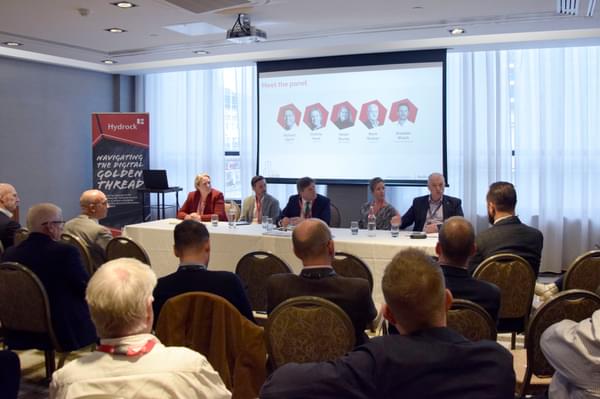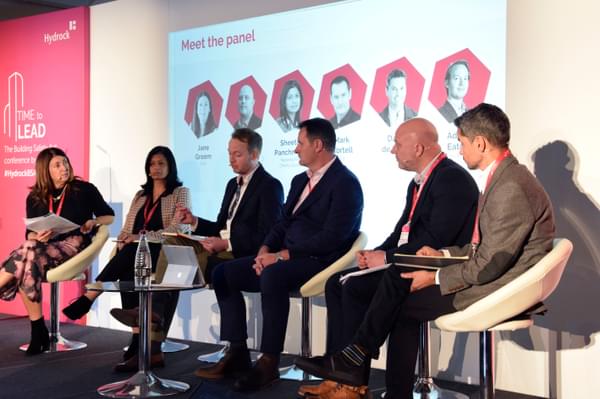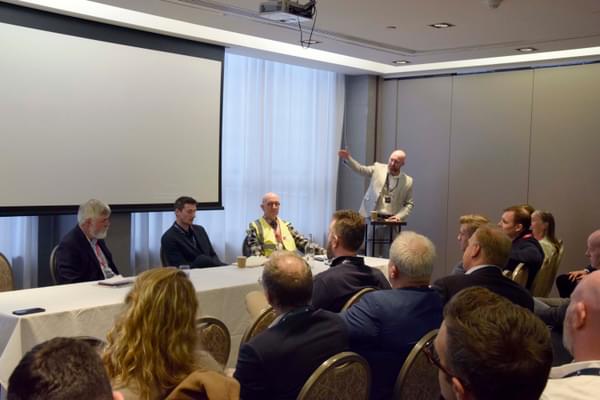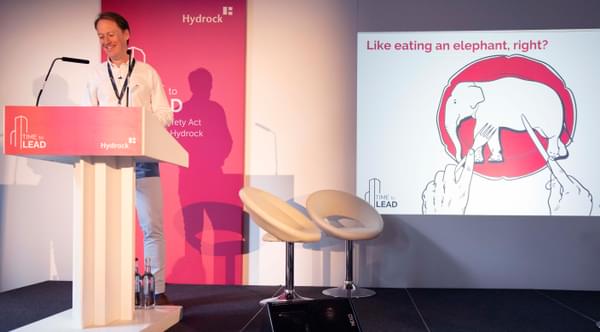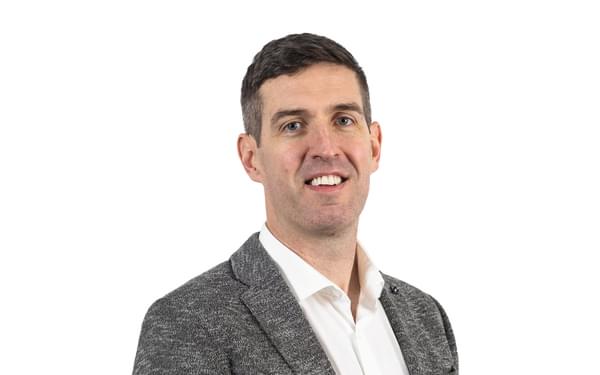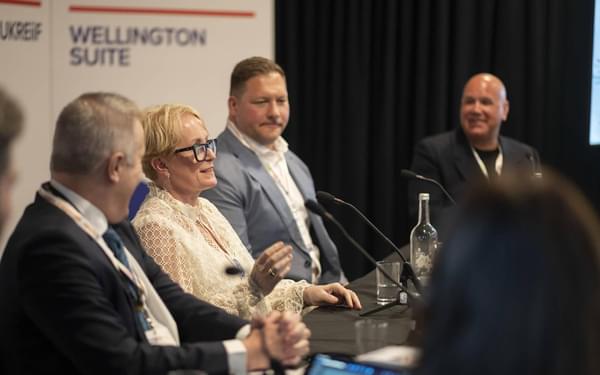Back to Articles
Building safety regulations: Time to Lead — Can the building industry regulate itself?
31st Oct 2023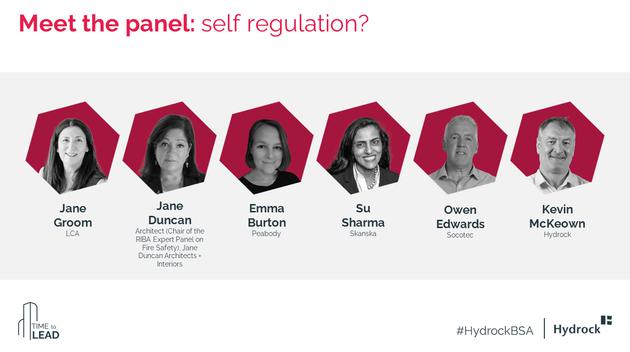
At our 'Time to Lead' conference on 18 October 2023, our main panel session explored whether the industry can, and should, regulate itself in regards to the stricter regime of responsibility and accountability that the Building Safety Act is bringing in. Building safety has been placed front and centre of the agenda, and it’s vital we get it right.
Chaired by Jane Groom, Partner and Co-Managing Director of Politics, Engagement and Planning at London Communications Agency, the panel included architect Jane Duncan, former RIBA president and current chair of the RIBA Expert Panel on Fire Safety, Emma Burton, Assistant Director of Building Safety at Peabody, Su Sharma, Legal Counsel (Consultant) for Skanska UK Plc, Owen Edwards, Technical and Training Director at Socotec, and Kevin McKeown, Divisional Director of Fire Safety at Hydrock.
Our panel of experts provided a variety of perspectives from across the building industry about who should be leading the change and debated whether there are better ways of regulating the industry to ensure the delivery of safe buildings.
Several major themes emerged from the discussion, which we've rounded up here:
1. Shared responsibility to build safely
Jane Groom kicked off the discussion by asking our panel whether we are ready to embrace this level of regulatory change as an industry, and the responsibility that comes with it. Jane Duncan jumped in, acknowledging that work has started on competence, but that is just the start of cultural change. "I think one of the things that we've got to knock on the head more than irresponsibility is complacency, and that's been an issue [for the industry] for decades", she said. "Because people have become complacent and they just copy and paste. It's very much easier to do what you did before or what somebody else has done."
She argued that the Building Safety Act puts more collective responsibility on the industry, but also on the Government and particularly on the Client, than ever before. "We need to understand each other, so we need to work together and I don't think that's a very difficult thing to say, but it's an incredibly difficult thing to do. This is one of those times when we can start to do that," she said.
Owen Edwards of Socotec agreed that the Building Safety Act is not changing much from a technical perspective, but redefining roles and responsibilities to ensure building safety. "It is just what we do and how we do it and who is responsible for it," he said. He noted that we're all connected as part of the same building, and have a shared responsibility across its entire life cycle, not just the stage we're engaged on. He commented that the Building Safety Act can act as a framework that connects those different stages together, adding, "that requirement for collaboration and cooperation between all of the duty holders that are involved across a project is a fundamental change."
"We have to have an oversight of the whole process, cradle to grave. An oversight of the people who will use the building and the impact the building will have on society. So, we have to break those bits down and understand where my small part [of the bigger picture comes in] within that design and construction element," he said.
Kevin McKeown agreed, commenting "We are in this together and we've got to move forward together, be more collaborative, and press forward."
2. Understanding the digital golden thread
The discussion also covered the practicalities of a specific new requirement of the Act: the digital golden thread.
Kevin McKeown noted that in his role developing Hydrock's digital golden thread service, he's been heartened by the way building safety has been prioritised across the industry. He noted that the digital golden thread is bringing in ongoing accountability to all aspects of the industry, from key stakeholders to workers on-site installing and updating systems. "You've now got to prove it and you've got to keep proving it. You've got to prove it during design, construction and during the building's occupation," he said. "Ultimately, the digital golden thread is data logging. It's traceability."
Jane Duncan commented that we need to embrace this new approach to information sharing. "It's not rocket science. It's not brain surgery," she said. " We just need to do it. And we need to all agree to do it. And that's the point: let's work together."
Emma Burton from Peabody also shared the resident's perspective on the digital golden thread. She said, "They [residents] don't want us to get caught up in the complexities of the Building Safety Act, in sharing all the information. They want building managers to have the right information to make the right decisions, and I think that that sometimes gets a bit overlooked.
She reminded us of the huge amount of information generated during the construction phase, noting it is up to us to ensure building managers are given the right information to make day-to-day decisions.
"I think that's something that really needs to involve the client right at the beginning. Making sure that those conversations are had so that you can pick the bits in the golden thread that are going to help managers, rather than just give them the whole lot in one big go because that won't actually be useful."
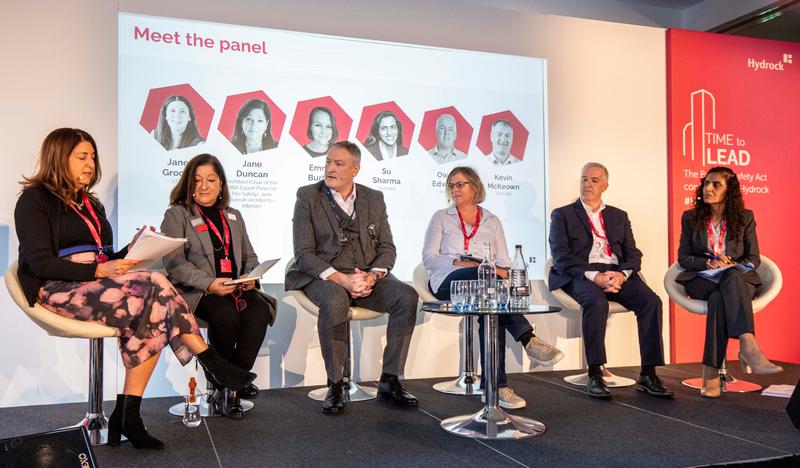
3. Building back trust
Emma, who is leading a building safety audit for over 100,000 homes at Peabody, went on to remind us all of the purpose of the day. "The thing to remember is that residents are at the heart of all of this. The reason we're all here is so that we create buildings that keep residents safe," she said. She referenced Professor Jose Torero's keynote speech earlier in the day, and reinforced his point that trust is key. "Residents don't really want to be engaged," she shared. "What they want to do is trust their landlord to be able to keep them safe in their building."
But rebuilding that trust is going to be a very long journey, she noted, warning against engagement for engagement's sake. "Residents want to be engaged when things change. They want to be engaged when there are construction projects or remediation going on. That's when they want to know what's going on - and why."
One way to rebuild trust, and engage with residents well, she noted, is to keep things simple and safe. "How are residents going to understand what it keeping them safe in this building? And how are they going to understand what to do if there's a fire?" she asked. "If we create lots of layers of complexity, put in different smoke ventilation systems, alternative routes for evacuation, complicated escape routes, that is not doing residents any good."
Jane Groom commented that "This is a human story. It's about protecting people, earning their trust and respecting their right to live safely in their home."
Su Sharma agreed that it is very much a human story, noting how she had to have difficult professional conversations about whether Grenfell Tower may have been intentionally overlooked because of the socio-economic profile of its residents.
"Though we have an obligation as an industry to build safe, we also need to make sure that communities are never again put in the position where they feel discriminated," she said. The outcome of those conversations was that Grenfell happened through "complete negligence. People didn't think about who was actually going to occupy it. So, there is an absolute obligation on all of us to construct safely, and to not divide communities."
Emma acknowledged the financial situation from perspective of a housing association, concluding that while balancing resources is tricky, "I think the feeling generally across the social housing sector is that we haven't been putting enough attention to our existing homes and looking after them and looking after the people that are in them."
4. How the Building Safety Act is changing process
The role of the Building Safety Regulator and the wider changing role of building control within a project was another major talking point. Jane Duncan commented that she hopes it will be a watchdog with bite, remembering the District Surveyors of her early career in London, who she described as being “scary as hell.”
Kevin McKeown noted that the former safety net of building controllers and approved inspectors has been taken away. “They are no longer a catch-all. It's up to us to develop solutions.”
Owen Edwards from Socotec went further on that cultural shift towards a more proactive mindset. Duty holders will now need to approach building control able to demonstrate the ways in which the design or building meets regulations, rather than asking whether it complies or not.
“If you ask, you shouldn't get an answer. The question should come right back to you,” he said. “You're the competent person. You, in your specialist field, are going to have more competence than me. You tell me how you think it complies. Acting as a critical friend, I will then tell you if it makes sense to me, but ultimately, we’re shifting to a model of ‘Now, show me your working of how you've got to your answer’.”
He also commented that the culture within building control needs to shift to one of being able to comfortably challenge dutyholders, and that dutyholders need to get used to holding each other constantly accountable, too. “Then,” he added, “we can have that discussion, collaboration and cooperation.” Demonstrating individual and collective competence will form a big part of that.
On competence, Kevin added: “I think that the only person that can hold a competent professional to account is another competent professional. I believe that by involving ourselves in any type of project we're going to have to rely on peer review.”
Su Sharma commented that the product itself hasn’t changed much. She said, “What's changed is the process. We've got to comply with the process and we've got to demonstrate that we have done that. And that should actually save us money because if we are doing it properly, then we won't have to go back and redo things again to ensure they're safe.”
She shared that, through a building safety task force, Skanska are embedding the Building Safety Act across all their processes and procedures from the very beginning of a project, including working in competence and changing contracts to reflect the requirements of the Building Safety Act. As such, she said, she welcomes the current higher risk residential building gateway processes being introduced across the entire industry, bringing about a uniform approach.
5. What is the true cost of the Building Safety Act?
During the Q&A portion of the discussion, an audience member asked the panel: “What do you think the cost of applying the Building Safety Act is? I'm not particularly looking for a number, but what's the real cost?”
Jane Duncan shared her perspective on true value. She said “I don't think you can put figures or even a view on this, but what I do think we can have a view on, collaboratively, is how much you pay to get a good result. I think one of the issues has been that cheap is best. I'm sorry, but good value is best. These things do take time to get right. It goes back to the client who needs to understand that good value is much better than cheap.”
A member of our audience agreed with her that, “What's led to all this, which I think everyone knows, has been this race to the bottom" in terms of cost.
Su Sharma reinforced her earlier point. “I don't anticipate compliance costing too much because it's what we should be doing anyway,” she said, sharing that they have managed to implement a system at Skanska while doing their day jobs and with minimal spend.
Kevin McKeown shared his optimism around return on investment. He acknowledged that there may need to be some investment around new systems for the digital golden thread, for example. He pointed out that “Studies by Atkins and KPMG have stated that every pound spent on information technology gives you six pounds back over five years. I'd like to think that it could be cost neutral in five years’ time."
In conclusion
Having covered the enormous ground that is the Building Safety Act, the panel wrapped up and shared their concluding thoughts.
Su’s final takeaway was an observation on how change is possible, remembering a time before seatbelts were mandatory, or previous decades when drink-driving was culturally acceptable. Kevin agreed: “For me, it's confidence. I think we're in a much better position than we actually think we are.”
Jane Groom shared again that it’s all about the people, both the residents and the people working on these buildings. “I'm going to take away three words. So, it's about culture change, it's about competence, but all that then leads to confidence and hopefully all of those three together leads to rebuilding trust with our communities and residents,” she said.
Key takeaways
- We need to be able to have honest (if uncomfortable at first) conversations. That’s how we’ll be able hold each other constantly accountable as an industry.
- It’s all about changing our behaviour to embrace collaboration – let’s work together and press forward.
- Don’t forget the residents – they deserve a safe building and a process they can trust.
- Let’s be positive – we can do this. Remember, you’re not alone out there.
Stay informed with our dedicated newsletter featuring news and updates, the latest talking points and everything else you might need to know about the Building Safety Act. Sign up here.
